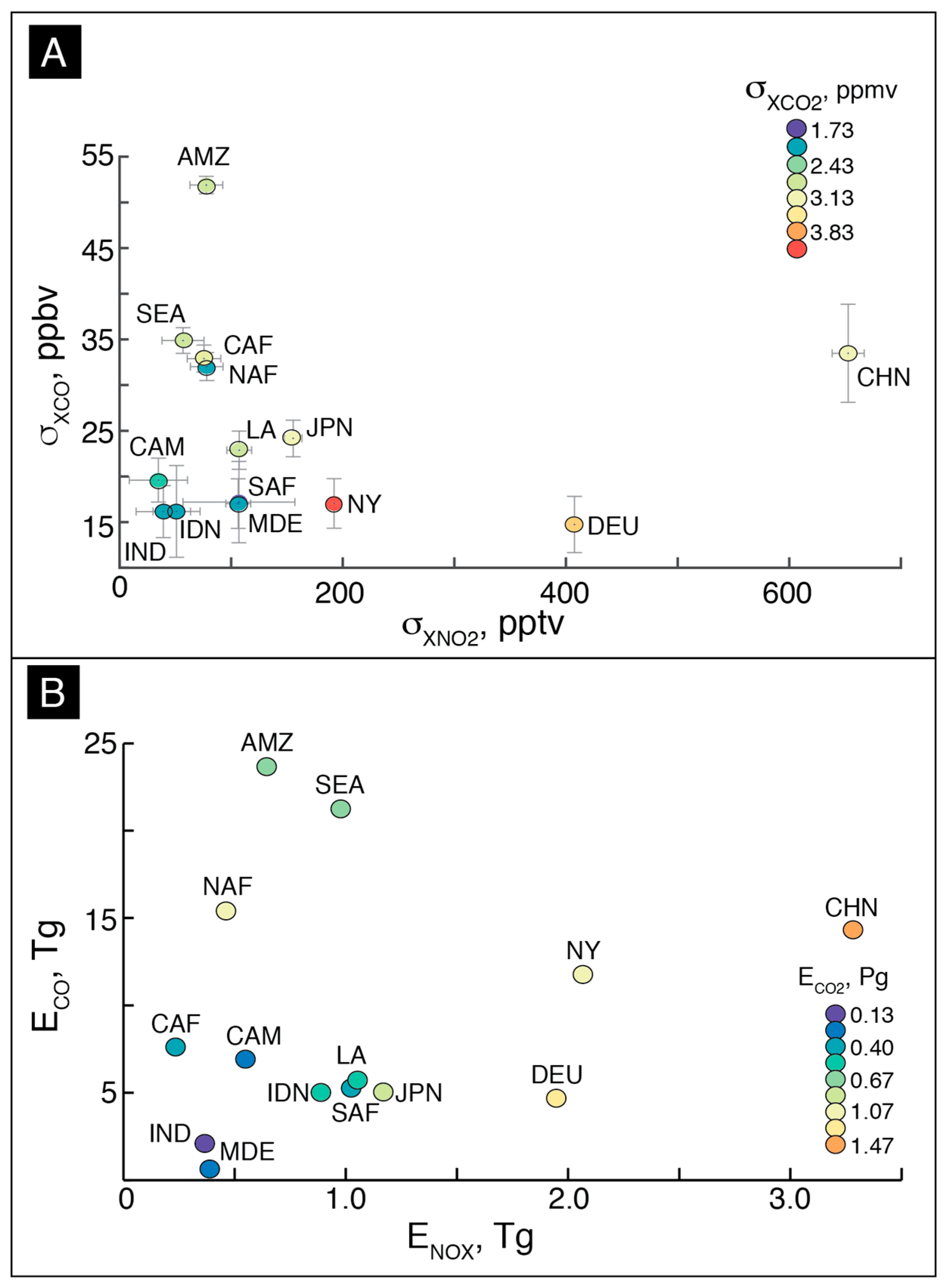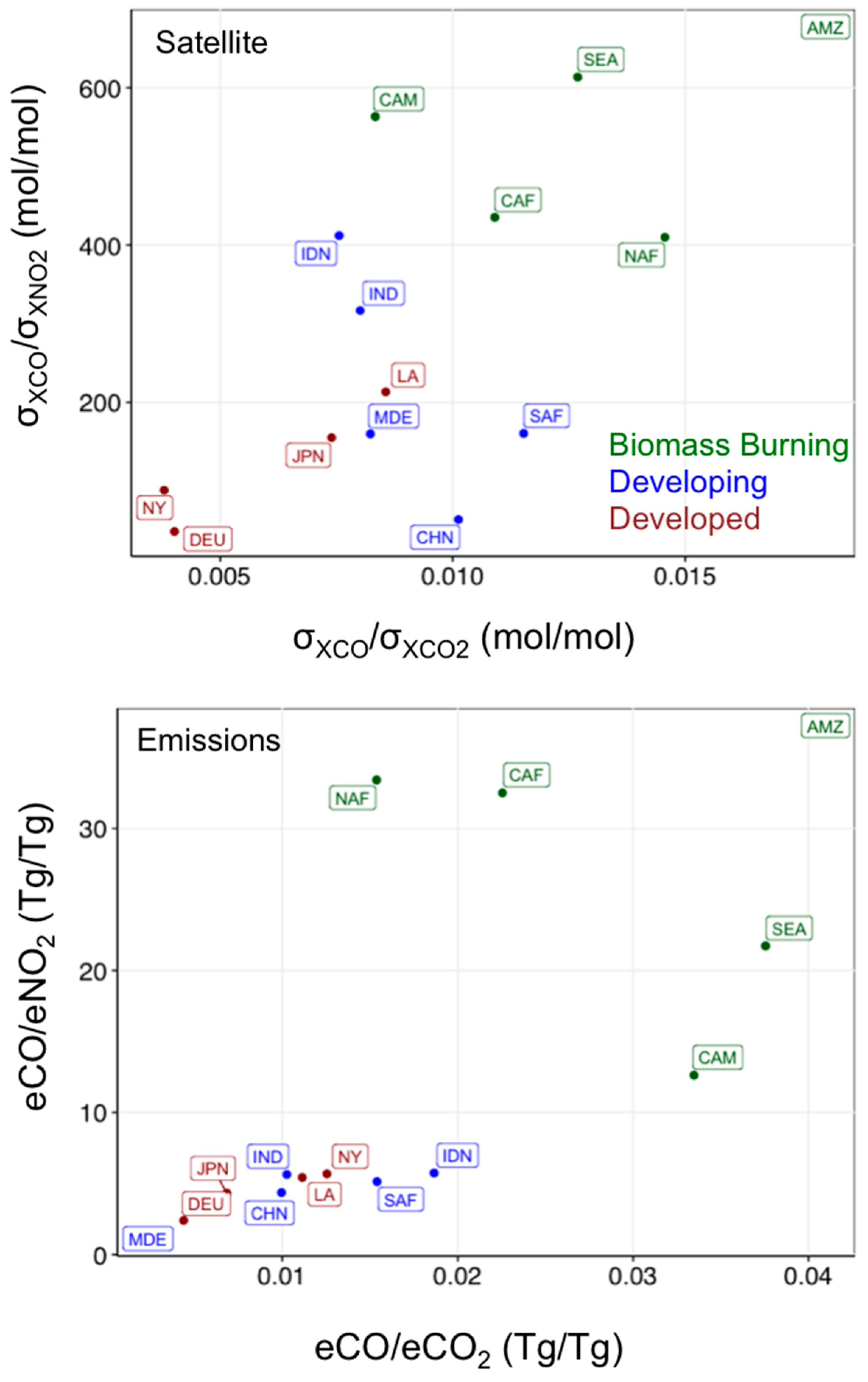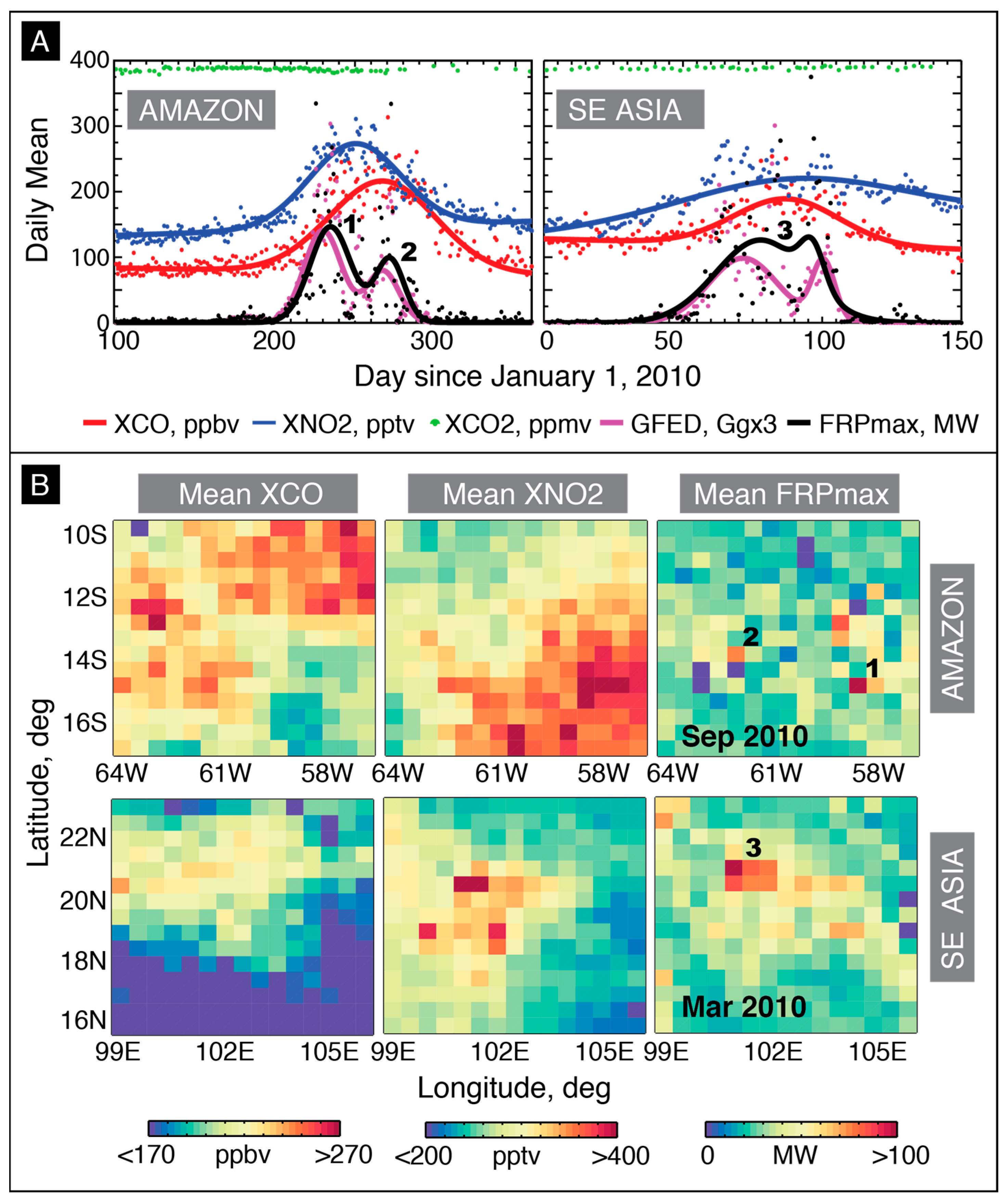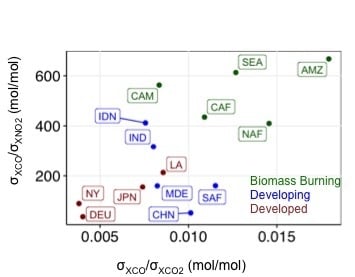Characterizing Regional-Scale Combustion Using Satellite Retrievals of CO, NO2 and CO2
Abstract
:1. Introduction
2. Data and Methods
2.1. Satellite Retrievals and Ancillary Datasets
2.2. Regional Enhancements
2.2.1. Spatiotemporal Filtering
2.2.2. Atmospheric Enhancements
3. Results and Discussion
3.1. Bulk Characteristics in Combustion Regions
3.2. Bulk Characteristics in Fire Regions
3.3. Bulk Characteristics in Megacities
4. Summary and Implications
Appendix A
A.1. Bootstrapping Methodology
A.2. Time Periods and Selection Regions
Acknowledgments
Author Contributions
Conflicts of Interest
References
- Zhu, T.; Melamed, M.; Parrish, D.; Gauss, M.; Klenner, L.G.; Lawrence, M.; Konare, A.; Liousse, C. WMO/IGAC Impacts of Megacities on Air Pollution and Climate. Available online: http://www.wmo.int/pages/prog/arep/gaw/documents/GAW_205_DRAFT_13_SEPT.pdf (accessed on 6 June 2017).
- Creutzig, F.; Baiocchi, G.; Bierkandt, R.; Pichler, P.P.; Seto, K.C. Global typology of urban energy-use and potentials for an urbanization mitigation wedge. Proc. Natl. Acad. Sci. USA 2015, 112, 6283–6288. [Google Scholar] [CrossRef] [PubMed]
- Hutyra, L.R.; Duren, R.; Gurney, K.R.; Grimm, N.; Kort, E.A.; Larson, E.; Shrestha, G. Urbanization and the carbon cycle: Current capabilities and research outlook from the natural sciences perspective. Earth’s Future 2014, 10, 473–495. [Google Scholar] [CrossRef]
- Duncan, B.N.; Prados, A.I.; Lamsal, L.N.; Liu, Y.; Streets, D.G.; Gupta, P.; Hilsenrath, E.K.; Ralph, A.; Nielsen, J.E.; Beyersdorf, A.J.; et al. Satellite data of atmospheric pollution for US air quality applications: Examples of applications, summary of data end-user resources, answers to FAQs, and common mistakes to avoid. Atmos. Environ. 2014, 94, 647–662. [Google Scholar] [CrossRef]
- Martin, R.V. Satellite remote sensing of surface air quality. Atmos. Environ. 2008, 42, 7823–7843. [Google Scholar] [CrossRef]
- Pommier, M.; Mclinden, C.A.; Deeter, M. Relative changes in CO emissions over megacities based on observations from space. Geophys. Res. Lett. 2013, 40, 3766–3771. [Google Scholar] [CrossRef] [Green Version]
- Hakkarainen, J.; Ialongo, I.; Tamminen, J. Direct space-based observations of anthropogenic CO2 emission areas from OCO-2. Geophys. Res. Lett. 2016, 43. [Google Scholar] [CrossRef]
- Duncan, B.N.; Lamsal, L.N.; Thompson, A.M.; Yoshida, Y.; Lu, Z.; Streets, D.G.; Pickering, K.E. A space-based, high-resolution view of notable changes in urban NOx pollution around the world (2005–2014). J. Geophys. Res. Atmos. 2016, 121, 976–996. [Google Scholar] [CrossRef]
- Flagan, R.C.; Seinfeld, J.H. Fundamentals of Air Pollution Engineering; Courier Corporation: Mineola, NY, USA, 2013. [Google Scholar]
- Parrish, D.D.; Kuster, W.C.; Shao, M.; Yokouchi, Y.; Kondo, Y.; Goldan, P.D.; Shirai, T. Comparison of air pollutant emissions among Mega-Cities. Atmos. Environ. 2009, 43, 6435–6441. [Google Scholar] [CrossRef]
- Pollack, I.B.; Ryerson, T.B.; Trainer, M.; Neuman, J.A.; Roberts, J.M.; Parrish, D.D. Trends in ozone, its precursors, and related secondary oxidation products in Los Angeles, California: A synthesis of measurements from 1960 to 2010. J. Geophys. Res. 2013, 118, 5893–5911. [Google Scholar] [CrossRef]
- Lopez, M.; Schmidt, M.; Delmotte, M.; Colomb, A.; Gros, V.; Janssen, C. CO, NOX and 13CO2 as tracers for fossil fuel CO2: Results from a pilot study in Paris during winter 2010. Atmos. Chem. Phys. 2013, 13, 7343–7358. [Google Scholar] [CrossRef]
- Lindenmaier, R.; Dubey, M.K.; Henderson, B.G.; Butterfield, Z.T.; Herman, J.R.; Rahn, T.; Lee, S.-H. Multi-scale observations of CO2, 13CO2, and pollutants at Four Corners for emission verification and attribution. Proc. Natl. Acad. Sci. USA 2014, 111, 8386–8391. [Google Scholar] [CrossRef] [PubMed]
- Hassler, B.; McDonald, B.C.; Frost, G.J.; Borbon, A.; Carslaw, D.C.; Civerolo, K.; Pollack, I.B. Analysis of long-term observations of NOx and CO in megacities and application to constraining emissions inventories. Geophys. Res. Lett. 2016, 43, 9920–9930. [Google Scholar] [CrossRef]
- Turnbull, J.C.; Karion, A.; Fischer, M.L.; Faloona, I.; Guilderson, T.; Lehman, S.J.; Miller, B.R.; Miller, J.B.; Montzka, S.; Sherwood, T.; et al. Assessment of fossil fuel carbon dioxide and other anthropogenic trace gas emissions from airborne measurements over Sacramento, California in spring 2009. Atmos. Chem. Phys. 2011, 11, 705–721. [Google Scholar] [CrossRef] [Green Version]
- Brioude, J.; Angevine, W.M.; Ahmadov, R.; Kim, S.W.; Evan, S.; McKeen, S.A.; Hsie, E.Y.; Frost, G.J.; Neuman, J.A.; Pollack, I.B.; et al. Top-down estimate of surface flux in the Los Angeles Basin using a mesoscale inverse modeling technique: Assessing anthropogenic emissions of CO, NOx and CO2 and their impacts. Atmos. Chem. Phys. 2013, 13, 3661–3677. [Google Scholar] [CrossRef]
- Silva, S.J.; Arellano, A.F.; Worden, H. Toward anthropogenic combustion emission constraints from space-based analysis of urban CO2/CO sensitivity. Geophys. Res. Lett. 2013, 40, 4971–4976. [Google Scholar] [CrossRef]
- Reuter, M.; Ryerson, T.B.; Trainer, M.; Neuman, J.A.; Roberts, J.M.; Parrish, D.D. Decreasing emissions of NOx relative to CO2 in East Asia inferred from satellite observations. Nat. Geosci. 2014, 7, 792–795. [Google Scholar] [CrossRef]
- Konovalov, I.B.; Berezin, E.V.; Ciais, P.; Broquet, G.; Beekmann, M.; Hadji-Lazaro, J.; Clerbaux, C.; Andreae, M.O.; Kaiser, J.W.; Schulze, E.D.; et al. Constraining CO2 emissions from open biomass burning by satellite observations of co-emitted species: A method and its application to wildfires in Siberia. Atmos. Chem. Phys. 2014, 14, 10383–10410. [Google Scholar] [CrossRef] [Green Version]
- Konovalov, I.B.; Berezin, E.V.; Ciais, P.; Broquet, G.; Zhuravlev, R.V.; Janssens-Maenhout, G. Estimation of fossil-fuel CO2 emissions using satellite measurements of ‘proxy’ species. Atmos. Chem. Phys. 2016, 16, 13509–13540. [Google Scholar] [CrossRef]
- Berezin, E.V.; Konovalov, I.B.; Ciais, P.; Richter, A.; Tao, S.; Janssens-Maenhout, G.; Beekmann, M.; Schulze, E.-D. Multiannual changes of CO2 emissions in China: Indirect estimates derived from satellite measurements of tropospheric NO2 columns. Atmos. Chem. Phys. 2013, 13, 255–309. [Google Scholar] [CrossRef]
- Miyazaki, K.; Eskes, H.J.; Sudo, K. A tropospheric chemistry reanalysis for the years 2005–2012 based on an assimilation of OMI, MLS, TES and MOPITT satellite data. Atmos. Chem. Phys. 2015, 15, 8315–8348. [Google Scholar] [CrossRef]
- Inness, A.; Blechschmidt, A.M.; Bouarar, I.; Chabrillat, S.; Crepulja, M.; Engelen, R.J.; Eskes, H.; Flemming, J.; Gaudel, A.; Hendrick, F.; et al. Data assimilation of satellite retrieved ozone, carbon monoxide and nitrogen dioxide with ECMWF’s Composition-IFS. Atmos. Chem. Phys. 2015, 15, 5275–5303. [Google Scholar] [CrossRef]
- Fortems-Cheiney, A.; Chevallier, F.; Pison, I.; Bousquet, P.; Saunois, M.; Szopa, S.; Cressot, C.; Kurosu, T.P.; Chance, K.; Fried, A. The formaldehyde budget as seen by a global-scale multi-constraint and multi-species inversion system. Atmos. Chem. Phys. 2012, 12, 6699–6721. [Google Scholar] [CrossRef]
- Streets, D.G.; Timothy, C.; Gregory, R.C.; Benjamin, F.; Russell, R.D.; Bryan, N.D.; David, P.E.; John, A.H.; Daven, K.H.; Marc, R.H.; Daniel, J.J.; et al. Emissions estimation from satellite retrievals: A review of current capability. Atmos. Environ. 2013, 77, 1011–1042. [Google Scholar] [CrossRef]
- Measurements of Pollution in the Troposphere (MOPITT). Available online: https://www2.acom.ucar.edu/mopitt (accessed on 6 June 2017).
- Deeter, M.N.; Martínez-Alonso, S.; Edwards, D.P.; Emmons, L.K.; Gille, J.C.; Worden, H.M.; Pittman, J.V.; Daube, B.C.; Wofsy, S.C. Validation of MOPITT Version 5 Thermal-Infrared, near-infrared, and multispectral carbon monoxide profile retrievals for 2000–2011. J. Geophys. Res. 2013. [Google Scholar] [CrossRef]
- TEMIS–Tropospheric NO2. Available online: http://www.temis.nl/airpollution/no2.html (accessed on 6 June 2017).
- Boersma, K.F.; Jacob, D.J.; Bucsela, E.J.; Perring, A.E.; Dirksen, R.; van der A, R.J.; Yantosca, R.M.; Park, R.J.; Wenig, M.O.; Bertram, T.H.; et al. Validation of OMI tropospheric NO2 observations during INTEX-B and application to constrain NOX emissions over the eastern United States and Mexico. Atmos. Environ. 2008, 42, 4480–4497. [Google Scholar] [CrossRef] [Green Version]
- GOSAT Project. Available online: www.gosat.nies.go.jp (accessed on 6 June 2017).
- Crisp, D.; Frankenberg, C.; Messerschmidt, J.; Wennberg, P.O.; Wunch, D.; Yung, Y.L. The ACOS CO2 retrieval algorithm—Part II: Global XCO2 data characterization. Atmos. Meas. Tech. 2012, 5, 687–707. [Google Scholar] [CrossRef]
- Fire Information for Resource Management System. Available online: firms.modaps.eosdis.nasa.gov (accessed on 6 June 2017).
- Freeborn, P.H.; Wooster, M.J.; Roy, D.P.; Cochrane, M.A. Quantification of MODIS fire radiative power (FRP) measurement uncertainty for use in satellite-based active fire characterization and biomass burning estimation. Geophys. Res. Lett. 2014, 41, 1988–1994. [Google Scholar] [CrossRef]
- Global Fire Emissions Database. Available online: http://www.globalfiredata.org (accessed on 6 June 2017).
- Socioeconomic Data and Applications Center. Available online: http://sedac.ciesin.columbia.edu (accessed on 6 June 2017).
- EDGAR. Available online: http://edgar.jrc.ec.europa.eu (accessed on 6 June 2017).
- World Bank Open Data. Available online: http://data.worldbank.org (accessed on 6 June 2017).
- Ellis, E.C.; Ramankutty, N. Putting people in the map: Anthropogenic biomes of the world. Front. Ecol. Environ. 2008, 6, 439–447. [Google Scholar] [CrossRef]
- Bocquet, M.; Elbern, H.; Eskes, H.; Hirtl, M.; Zöabkar, R.; Carmichael, R.; Flemming, J.; Inness, A.; Pagowski, M.; et al. Data assimilation in atmospheric chemistry models: Current status and future prospects for coupled chemistry meteorology models. Atmos. Chem. Phys. 2015, 15, 5325–5358. [Google Scholar] [CrossRef]
- Orbiting Carbon Observatory. Available online: http://oco.jpl.nasa.gov (accessed on 6 June 2017).
- Kort, E.A.; Frankenberg, C.; Miller, C.E.; Oda, T. Space-based observations of megacity carbon dioxide. Geophys. Res. Lett. 2012, 39. [Google Scholar] [CrossRef]
- Fuglestvedt, J.; Berntsen, T.; Myhre, G.; Rypdal, K.; Skeie, R.B. Climate forcing from the transport sectors. Proc. Natl. Acad. Sci. USA 2008, 105, 454–458. [Google Scholar] [CrossRef] [PubMed]
- Andreae, M.O.; Merlet, P. Emission of trace gases and aerosols from biomass burning. Glob. Biogeochem. Cycles 2001, 15, 955–995. [Google Scholar] [CrossRef]
- Kaiser, J.W.; Heil, A.; Andreae, M.O.; Benedetti, A.; Chubarova, N.; Jones, L.; Morcrette, J.J.; Razinger, M.; Schultz, M.G.; Suttie, M.; et al. Biomass burning emissions estimated with a global fire assimilation system based on observed fire radiative power. Biogeosciences 2012, 9, 527–554. [Google Scholar] [CrossRef] [Green Version]
- Ichoku, C.; Ellison, L. Global top-down smoke-aerosol emissions estimation using satellite fire radiative power measurements. Atmos. Chem. Phys. 2014, 14, 6643–6667. [Google Scholar] [CrossRef] [Green Version]
- Tang, W.; Arellano, A.F., Jr. Investigating dominant characteristics of fires across the Amazon during 2005–2014 through satellite data synthesis of combustion signatures. J. Geophys. Res. Atmos. 2017, 121. [Google Scholar] [CrossRef]
- Mishra, A.K.; Lehahn, Y.; Rudich, Y.; Koren, I. Co-variability of smoke and fire in the Amazon Basin. Atmos. Environ. 2015, 109, 97–104. [Google Scholar] [CrossRef]
- Schreier, S.F.; Richter, A.; Kaiser, J.W.; Burrows, J.P. The empirical relationship between satellite-derived tropospheric NO2 and fire radiative power and possible implications for fire emission rates of NOx. Atmos. Chem. Phys. 2014, 14, 2447–2466. [Google Scholar] [CrossRef]
- Ashford, N.A.; Caldart, C.C. Environmental Law, Policy, and Economics: Reclaiming the Environmental Agenda; MIT Press: Cambridge, MA, USA, 2008. [Google Scholar]
- Liu, Z.; Guan, D.; Wei, W.; Davis, S.J.; Ciais, P.; Bai, J.; Peng, S.; Zhang, Q.; Hubacek, K.; Marland, G.; et al. Reduced carbon emission estimates from fossil fuel combustion and cement production in China. Nature 2015, 524, 335–338. [Google Scholar] [CrossRef] [PubMed]
- Wecht, K.J.; Jacob, D.J.; Sulprizio, M.P.; Santoni, G.W.; Wofsy, S.C.; Parker, R.; Bösch, H.; Worden, J. Spatially resolving methane emissions in California: Constraints from the CalNex aircraft campaign and from present (GOSAT, TES) and future (TROPOMI, Geostationary) satellite observations. Atmos. Chem. Phys. 2014, 14, 8173–8184. [Google Scholar] [CrossRef] [Green Version]
- DISCOVER-AQ Program Home. Available online: http://discover-aq.larc.nasa.gov (accessed on 6 June 2017).





| Satellite Instrument and Retrieval | Sampling Characteristics | Retrieval Data Characteristics |
|---|---|---|
| (Spectral Region, Resolution, Repeat Cycle, Overpass Time) | (Available Period, Website, Uncertainty, References) | |
| NASA Terra, Measurement of Pollution In The Troposphere (MOPITT v5J), CO total column | TIR/NIR, 22 km, 16 days, 10:30 a.m. | 2000–today, [26], 6–8%, [27] and references therein |
| NASA Aura, Ozone Monitoring Instrument (OMI v2 DOMINO), NO2 trop. column | UV/VIS, 13–26 km, 16 days, 1:45 p.m. | 2004–today, [28], 0.5–1.5e15 molec/cm2, [29] and references therein |
| JAXA GOSAT, Thermal And Near-infrared Sensor for carbon Observation (TANSO-FTS, NASA ACOS b3.3), CO2 column | SWIR, 10.5 km, 3 days, 12:49 p.m. | 2009–today, [30], 1–1.5 ppm, [31] and references therein |
| NASA Terra/Aqua, Moderate Resolution Imaging Spectrometer (MODIS FIRMS MCD14ML c5), FRP | TIR, 1 km, 16 days, 10:30 a.m./1:30 p.m. | 2000/2002–today, [32], 26.6%, [33] and references therein |
© 2017 by the authors. Licensee MDPI, Basel, Switzerland. This article is an open access article distributed under the terms and conditions of the Creative Commons Attribution (CC BY) license (http://creativecommons.org/licenses/by/4.0/).
Share and Cite
Silva, S.J.; Arellano, A.F. Characterizing Regional-Scale Combustion Using Satellite Retrievals of CO, NO2 and CO2. Remote Sens. 2017, 9, 744. https://doi.org/10.3390/rs9070744
Silva SJ, Arellano AF. Characterizing Regional-Scale Combustion Using Satellite Retrievals of CO, NO2 and CO2. Remote Sensing. 2017; 9(7):744. https://doi.org/10.3390/rs9070744
Chicago/Turabian StyleSilva, Sam J., and A. F. Arellano. 2017. "Characterizing Regional-Scale Combustion Using Satellite Retrievals of CO, NO2 and CO2" Remote Sensing 9, no. 7: 744. https://doi.org/10.3390/rs9070744






